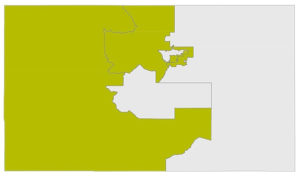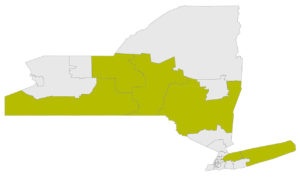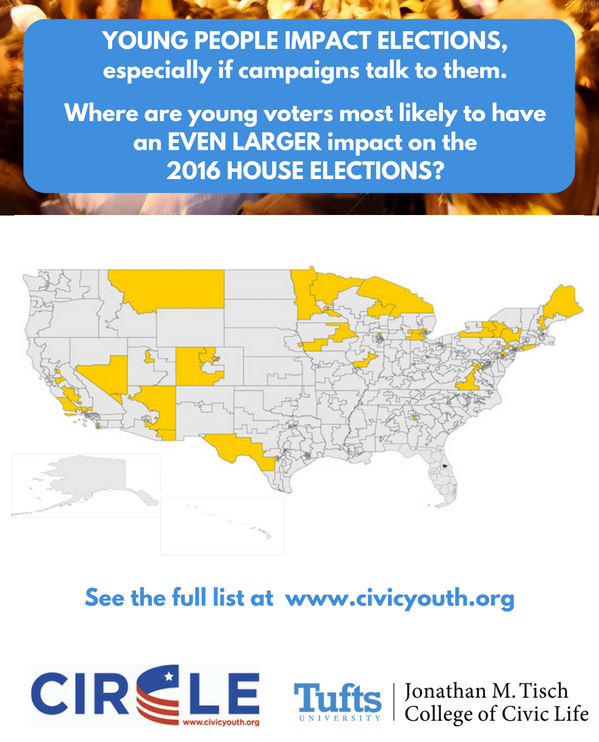Top 50 Districts Where Young People May Impact the 2016 Congressional Elections
In February 2016 we released our exclusive Youth Electoral Significance Index (YESI), a statistical model-driven ranking of the states and congressional districts where young people have the highest potential to play a critical role in shaping the Presidential race, as well as House and Senate races, this November. YESI is based on a CIRCLE analysis of more than a dozen indicators, including demographic data, historical voting patterns, and projected competitiveness in 2016. (For more information on methodology, see the end of this document.)
Initially, we published a Top 10 of the Presidential, Senate, and Congressional rankings. Today, we expand the latter and introduce the YESI Top 50 Congressional Districts using updated data. These districts are characterized by some combination of factors that suggest a high potential for youth electoral significance: a substantial population of young people, a socioeconomic profile historically consistent with high turnout, and in many cases a significant number of higher education institutions. Many are also “districts to watch” with a recent trend of close races or the expectation that it will be newly competitive in 2016.
The highest-ranked congressional districts in our Top 50 are, in order: the Iowa 1st (Dubuque, Cedar Rapids); the Colorado 2nd, described further below; the Maine 2nd (Bangor, Lewiston, Auburn); the Iowa 3rd (Des Moines); and the Minnesota 2nd, also described below.
The full YESI Top 50 list can be found here and visualized on the map. Below, we focus on several states with multiple districts on our list, and briefly describe some of the district-level characteristics. Additionally, while statewide redistricting in 2016 and a lack of full data prevent us from producing comparable rankings for congressional districts in Florida, our analysis suggests there is high potential for youth impact in several districts in that hotly contested state.
We believe the YESI Top 50 can be a valuable tool for campaigns, media, educators, and practitioners to identify the races across the country where young people are poised to have an impact on federal elections.
Arizona
Arizona, which is also in our Senate Top 10 ranking, will likely be a highly competitive state in November. Three of its districts make the YESI Top 50:
- Rank: 12 — Arizona 1st (eastern AZ and Flagstaff): This mostly rural district has the largest Native American population of any district in the country, as well as a large Hispanic population. In 2012, the congressional race was decided by less than 10,000 votes and young people cast many more ballots. This year’s congressional race is for an open seat and considered a toss-up.
- Rank: 29 — Arizona 2nd (southeast AZ and some of Tucson): The Arizona 2nd is home to more than 110,000 young eligible voters and more than 50,000 college students at 10 higher education institutions, as well as the nearby University of Arizona.[1] In 2012, the number of votes cast by young people far outpaced the margin of victory in a race that was decided by less than 2,500 votes; in 2014 it was decided by less than 200 votes.
- Rank 32 — Arizona 9th (Tempe, Mesa and some areas north of Phoenix): A new district created after the 2010 census, the Arizona 9th is home to more than 150,000 young potential voters, making up 23% of its citizen population, and there is a very large college student population in the district at 17 colleges and universities like Arizona State. (Many are also online students of the University of Phoenix.) As in the other two Arizona districts in this ranking, the number of youth who voted in 2012 surpassed that election’s margin of victory.
Colorado
 Another potential 2016 battleground state which also made the YESI Presidential and Senate Top 10, Colorado has three districts on this list, including the #2 district in our ranking:
Another potential 2016 battleground state which also made the YESI Presidential and Senate Top 10, Colorado has three districts on this list, including the #2 district in our ranking:
- Rank: 2 — Colorado 6th (eastern part of the Denver-Aurora metro area): The Colorado 6th nearly tops the ranking, behind only the Iowa 1st, largely due to its competitiveness: in 2012, young people cast far more ballots in the district than the election’s 7,000-vote margin of victory, and the seat is expected to be highly contested again this year.
- Rank: 25 — Colorado 3rd (southern and western portions of the state): The Colorado 3rd is a largely rural district with about 113,000 youth. While some prognosticators consider its congressional race “safe,” at least one source ranks it as competitive. Close to one quarter of the district’s population is Hispanic.
- Rank: 37 — Colorado 1st (Denver, Glendale, Englewood): The Colorado 1st boasts over 110,000 college students at 18 higher education institutions. Young people make up 20% of the district’s population, and tens of thousands of youth cast ballots in 2012. Additionally, 29% of the district’s population identifies as Hispanic, and up to a quarter of residents speak languages other than English. Like the Colorado 2nd, in 2014 youth turnout in the Colorado 1st was among the highest in the country (30%).
- Rank: 43 — Colorado 2nd (Boulder, Fort Collins, Vail): The district has close to 140,000 young eligible voters, making up 20% of its citizen population. Tens of thousands of youth went to the polls in 2012, and there is a large population of more than 110,000 college students at institutions like UC-Boulder and Colorado State University.
Michigan
Four Michigan districts make the cut, including two among the top 15:
- Rank: 7 — Michigan 7th (parts of Lansing, western suburbs of Ann Arbor and southeast corner of the state): This southern Michigan district, inhabited by a predominantly White, working class population, is expected to be highly contested this November. Nearly 10,000 youth attend college, which provides potential for electoral engagement.
- Rank: 13 — Michigan 1st (Upper Peninsula and a northern counties in the Lower Peninsula): Like the MI 7th, this district has just under 100,000 young eligible voters, many of whom voted in 2012 when the incumbent kept his seat by a margin of less than 2,000 votes. There are also 12 higher education institutions in the district, with a total of close to 20,000 enrolled students.
- Rank: 39 — Michigan 8th (Clinton, Ingham, and Livingston counties): The Michigan 8th has 125,000 young eligible voters. While there are only five colleges and universities in the district, proper, it is home to nearly 110,000 enrolled students, including many who attend nearby Michigan State University. Compared to the two Michigan districts that place higher in our ranking, this district has more college-educated adults and a higher median income, and had a higher turnout in 2012; however, the MI 1st and MI 7th are expected to have closer races than MI 8th.
- Rank: 41 – Michigan 11th (western suburbs of Detroit, Troy): This well-off district is over 80% white, has 88,000 young citizens, and boasts 13 institutions of higher education. Many young people went to the polls in 2012. While not expected to be extremely competitive, forecasters disagree on whether this district is “safe” or not.
Minnesota
One of the states with the highest levels of political engagement in the country, Minnesota features prominently in our ranking, with five of its eight congressional districts among the YESI Top 50 (with two additional districts within the top-75):
- Rank: 5 — Minnesota 2nd (Scott, Dakota, Goodhue, Wabasha counties): The district boasts nearly 95,000 young eligible voters, many of whom cast ballots in 2012, when the election was decided by less than 30,000 votes. The district also has an overall highly educated, predominantly white population.
- Rank: 23 — Minnesota 3rd (western suburb of Minneapolis): The district spans across communities of mixed income as well as racial and ethnic diversity in the western suburbs of Minneapolis. Its residents have very high levels of education (46% with college degrees and 95% with high school diplomas), and are predominantly white. In 2012, this district recorded some of the highest district-level youth participation in the nation.
- Rank: 24 — Minnesota 8th (Duluth and northeastern MN): The Minnesota 8th has 95,000 young potential voters, as well as 27,000 college students at 14 higher education institutions. Its congressional election, a rematch of the 2014 race that was decided by less than 4,000 votes, is expected to once again be close.
- Rank: 35 — Minnesota 5th (Minneapolis): More than 140,000 young eligible voters—23% of its citizen population—may play a significant role in this district, home to 19 colleges and universities, including the state university’s main campus.
- Rank: 46 — Minnesota 7th (western MN): This rural district has 14 higher education institutions and nearly 100,000 young people. The district population is largely white and middle-class, with just 20% of adults holding college degrees.
New York
 While New York may be a reliably Democratic state in Presidential and Senate elections, many districts’ Congressional races are much more fiercely contested. Six such districts place in the YESI Top 50.
While New York may be a reliably Democratic state in Presidential and Senate elections, many districts’ Congressional races are much more fiercely contested. Six such districts place in the YESI Top 50.
- Rank 8 — New York 22nd (Utica, Oneida, Cortland): This district in the central region of the state, west of Albany, has been recently forecast as a toss-up. The district is home to almost 85,000 students, many of whom attend large colleges like SUNY Cortland and Colgate University. Despite a significant number of students, the area’s adult population is largely working class: only 23% have college degrees and 15% live in poverty.
- Rank: 11 — New York 19th (Hudson Valley and Catskills): The race for the open seat in the New York’s 19th is one of the most watched congressional contests in the nation. There is significant potential for the 105,000-plus youth in the district to decide the race.
- Rank: 14 — New York 24th (Syracuse, Oswego and Eastern Finger Lakes region): Another district projected to be competitive this November, the New York 24th has nearly 120,000 young eligible voters and 80,000 students enrolled at large institutions like Syracuse University. The 2012 election there was decided by less than 30,000 votes.
- Rank: 16 — New York 1st (eastern Long Island): This economically diverse district that includes both working-class towns and the Hamptons is home to nearly 100,000 young potential voters and more than 10,000 college students. It is considered a battleground district in 2016.
- Rank: 22 – New York 3rd (northwestern Long Island): This open House seat is in a district with a high median income, and where almost half of the residents have a college degree. More than a quarter of the district population speak another language at home and one-fifth of the population was born abroad. There are 80,000 young citizens in the district.
- Rank: 28 — New York 23rd (western New York-Pennsylvania border): Close to 130,000 young eligible voters call this district home, and there are more than 75,000 college students at 16 institutions of higher education—notably Cornell University. Compared to the other New York congressional districts in this list, the NY 23rd has a lower median household income and fewer college-educated adults. As in similar districts with a high proportion of college students, young people’s impact on the congressional race may partially depend on where these students decide to cast their vote: in the New York 23rd, or elsewhere as absentee voters.
Virginia
Virginia went to Republicans from 1968-2004 before President Obama turned the state blue in 2008 and 2012. A close race is expected this year, and two of the state’s districts make our Congressional YESI Top 50 ranking.
- Rank: 31 — Virginia 10th (Frederick and Loudon Counties; Manassas): More than 85,000 young potential voters call this wealthy district home. It boasts high education levels; more than half of the district’s adult population has a college degree. It is also a diverse district; a quarter of its residents speak a languages other than English at home, and 12%, each, are Latino and Asian. Its congressional election is widely regarded as a race to watch this November.
- Rank: 50 – Virginia 5th (center of the state, including Charlottesville): The Virginia 5th is the largest district in Virginia, covering a central portion of the state, and is larger than the state of New Jersey. There are about 116,000 young eligible voters, and the district has a significant African American population (21%). Although the district has relatively few residents with college degrees (24%), youth turnout was high in 2012. The district is home to about 67,000 college students.
The perennial battleground state of Florida made the Top 10 in our earlier Senate and Presidential YESI rankings, but recent redistricting prevents us from calculating scores to compare the state’s congressional districts to those in other states. That said, there are several competitive races in Florida districts where youth are likely to have an impact, especially the Florida 7th, where there are many higher education institutions, youth make up 26% of the population, and there is generally a high rate of education compared to other districts in the state.
A Note on Methodology
Full details on the original YESI methods are here.
In preparing this updated analysis, we made two changes to our original YESI rankings released in February 2016. First, we obtained updated competitiveness rating information from the three analysts used earlier this year (Sabato, Cook Political Report, and Rothenberg/Gonzalez) on the Congressional Districts that are predicted to be competitive this November. Second, we changed the way we incorporate the level of competitiveness of the race into the final YESI score. Competitiveness ratings are at the core of our YESI rankings and weighted more heavily than other indicators. We gathered competitiveness ratings from three analysts who release their ratings publicly and translated them to a numerical scale, from 1 (safe) to 4 (toss-up). In this update, we added the competitiveness rating of 1, 2, 3, or 4 to the YESI as part of the scoring. In contrast, in February, we had given three points to any district that scored 2 or higher, meaning that a district was treated similarly whether it is a toss-up or “likely” but not totally safe. Now that the competitiveness ratings are more refined as we approach the election, we decided to add more nuance to the YESI score by varying the competitiveness points.
—
[1] Depending on the institution, the presence of colleges and universities in a district can increase the number of young people eligible to cast ballots. However, young people are in a range of situations while in college, and not all will choose to cast a ballot in the district where their school is located.
*****






